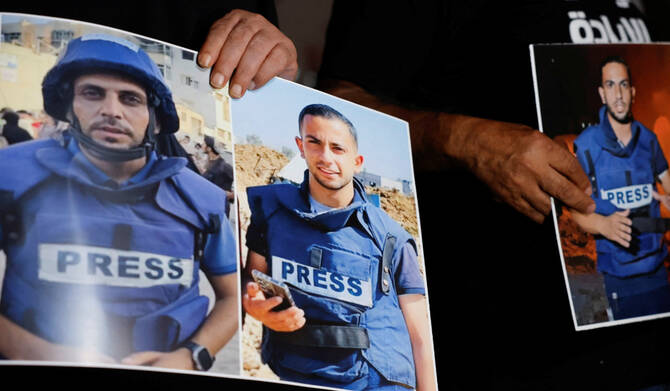Israeli Special Unit Linked Gaza Journalists to Hamas to Justify Their Killing, Investigation Reveals

Gaza (Quds News Network)- The Israeli military has operated a special unit known as the “Legitimization Cell,” tasked with identifying Gaza-based journalists it could portray as undercover Hamas members, in an effort to counter growing international outrage over Israel’s killing of journalists, the latest being Anas Al-Sharif, who was killed in a targeted Israeli airstrike last week.
According to +972 Magazine and Local Call, citing three intelligence sources, the unit, established after October 7, the unit tasked with gathering intelligence from Gaza that can bolster Israel’s image in the international media, including seeking information on Hamas’ alleged use of schools and hospitals for military purposes, and on failed rocket launched by Palestinian resistance groups that harmed civilians in the enclave.
It has also been assigned to identify Gaza-based journalists it could portray as undercover Hamas members, in an effort to blunt growing global outrage over Israel’s killing of reporters — the latest of whom was Al Jazeera journalist Anas Al-Sharif, killed in a targeted Israeli airstrike last week.
The Legitimization Cell’s motivation was not security, but public relations. Driven by anger that Gaza-based reporters were “smearing [Israel’s] name in front of the world,” its members were eager to find a journalist they could link to Hamas and mark as a target, one source said.
Its pattern: whenever criticism of Israel in the media intensified on a particular issue, the Legitimization Cell was told to find intelligence that could be declassified and employed publicly to counter the narrative.
“If the global media is talking about Israel killing innocent journalists, then immediately there’s a push to find one journalist who might not be so innocent — as if that somehow makes killing the other 20 acceptable,” the intelligence source said.
“The team regularly collected intelligence that could be used for hasbara — say, a stockpile of [Hamas] weapons [found] in a school — anything that could bolster Israel’s international legitimacy to keep fighting,” another source explained. “The idea was to [allow the military to] operate without pressure, so countries like America wouldn’t stop supplying weapons.”
The unit also sought evidence linking Gaza’s police to the October 7 operation, in order to justify targeting them and dismantling Hamas’ civilian security force, one source familiar with the Legitimization Cell’s work said.
Two of the intelligence sources recounted that, in at least one case since the war began, the Legitimization Cell misrepresented intelligence in a way that allowed for the false portrayal of a journalist as a member of Hamas’s military wing. “They were eager to label him as a target, as a terrorist — to say it’s okay to attack him,” one source recalled.
“They said: during the day he’s a journalist, at night he’s a platoon commander. Everyone was excited. But there was a chain of errors and corner-cutting.
“In the end, they realized he really was a journalist,” the source continued, and the journalist wasn’t targeted.
This applied to Israel’s assassiantion of Anas al-Sharif and Ismail al-Goul, two Al Jazeera journalists. Israel claimed they were “military wing operatives and Nukhba terrorists.”
The three intelligence sources said the army treated the media as an extension of the battlefield, allowing it to declassify sensitive intelligence for public release.
Even intelligence personnel outside the Legitimization Cell were told to flag any material that might aid Israel in the information war. “There was this phrase, ‘That’s good for legitimacy,’” one source recalled. “The goal was simply to find as much material as possible to serve hasbara efforts.”




